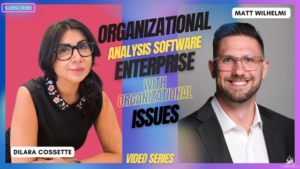EdTech Company and Their Clunky Sales Process
EdTech Company and Their Clunky Sales Process
- business consulting
- Business Strategy
- buyer qualification
- early-stage SaaS
- edtech company case study
- founder-led sales
- fractional revenue leader
- go-to-market strategy
- ICP
- ideal customer profile
- Lindsay Rios
- pricing structure
- Product-Led Growth (PLG)
- revenue growth
- SaaS consulting
- SaaS growth
- SaaS sales strategy
- sales process improvement

Lindsay Rios is a fractional revenue and growth leader with over ten years of experience, specializing in early-stage SaaS companies, particularly those with a Product-Led Growth (PLG) focus. Her expertise spans the full go-to-market strategy rather than just sales, emphasizing the customer lifecycle and organizational culture. She believes that a great organizational culture is essential to scaling companies successfully. She joins Matt Wilhelmi, Sr. Consultant with Strategic Voyages Business Consultants and author of Taboo Business Questions, to unpack a complex case study revolving around an EdTech Company and their clunky sales process.
This exciting conversation is hosted by Matt Wilhelmi, owner of Strategic Voyages Business Consultants and author of “Taboo Business Questions: What’s Haunting Every Entrepreneur’s Growth.”
Lindsay Rios and Matt Wilhelmi – Episode 1
Episode 1 begins with Lindsay’s Background and then dives into an exciting Case Study!
Case Study Overview
The case study discussed centers on an EdTech company undergoing due diligence as it prepares to secure investor funding. The company has a small team of ten employees, mostly software developers, and two employees handling sales presentations. However, the founder still drives most sales leads, leading to a largely unstructured sales process.
Their key challenge was a “clunky” sales process that hindered their scalability. Symptoms of the Case Study’s Organization The organization’s primary symptoms were:
- Poorly defined Ideal Customer Profile (ICP):
- While the company believed their ICP was higher education institutions, specifically university provosts, this assumption wasn’t fully validated or revisited as the market evolved.
- Lack of buyer qualification criteria:
- The company lacked a systematic way of qualifying leads. Leads were primarily handed over by the founder without clear qualifying metrics, resulting in inefficiencies in the sales process.
- Pricing structure uncertainty:
- The company had a basic pricing model involving implementation fees and per-seat charges. However, it was unclear whether this pricing structure was optimized for their long-term growth and customer acquisition goals.
Lindsay’s Approach to Diagnosing the Root Causes
To diagnose the root causes, Lindsay emphasizes asking key diagnostic questions:
- Evaluating the ICP:
- She starts by determining if the company has a clearly defined and aligned ICP across departments. She often finds that companies may have a rough idea but haven’t formalized or updated their ICP, leading to inefficiencies in targeting and outreach.
- Assessing the pipeline and qualifying criteria:
- Lindsay investigates how leads enter the sales pipeline and whether there are qualifying questions that help filter out poor leads. In this case, she identified that the company’s reliance on founder-led sales with little qualification was a red flag, contributing to their sales inefficiencies.
- Analyzing pricing strategy:
- She would also review the company’s pricing model, including implementation fees and per-seat pricing, to ensure it aligns with the company’s growth goals. She focuses on understanding the full customer journey, onboarding process, and customer success metrics, particularly the lifetime value (LTV) of customers and customer acquisition cost (CAC).
Lindsay’s method is rooted in uncovering the foundational issues that lead to a clunky sales process, ensuring that processes, pricing, and ICP are aligned for growth.
Lindsay Rios and Matt Wilhelmi – Episode 2
Cautionary Tales and Lessons Learned 🚩📉
In this episode, Lindsay Rios joins Matt Wilhelmi, Sr. Consultant with Strategic Voyages Business Consultants and author of Taboo Business Questions, to discuss three cautionary tales:
The Startup That Said Yes to Everything – In this cautionary tale, Lindsay worked with an early-stage SaaS company that struggled with focusing on a clear product or business strategy. The company had a validated proof of concept in the enterprise space, but they simultaneously tried to introduce a freemium model, despite the stark differences in required resources and sales motions between enterprise and freemium models. Additionally, the startup kept saying yes to every feature request from clients, leading to resource strain and a lack of strategic focus.
Lesson Learned: Trying to pursue multiple, contradictory strategies at once can dilute focus and resources, making it difficult to excel at any one approach. It’s important for startups to master one business model before expanding into others.
The Company with Stagnant Revenue Growth – Matt shared a story of a company that was puzzled by stagnant revenue growth despite acquiring new clients. Upon deeper investigation, it became clear that while the company boasted high retention rates, it had failed to properly track and account for churn. Their projections looked promising, but they were losing customers without even realizing it. The previous CFO hadn’t thoroughly monitored customer attrition, which revealed gaps in their understanding of customer lifetime value and acquisition costs.
Lesson Learned: Ignoring or downplaying churn can severely impact a company’s growth. Understanding customer retention, churn rates, and the customer journey is crucial for building a sustainable business.
The Founder Who Wouldn’t Let Go of Sales – Lindsay often encounters founders who are too attached to the sales process to delegate it effectively. In this case, a founder hired a sales leader but couldn’t step away, micromanaging every aspect of the sales process. This fear of losing control stunted the growth potential, as the founder’s involvement blocked the new sales leader from implementing strategies effectively. The founder’s fear of mistakes and lack of trust prevented the business from scaling.
Lesson Learned: Founders must learn to trust their hires and let go of control over certain functions, like sales, in order to scale the business. Failure to delegate or trust key leaders can lead to stagnation and turnover.
These tales highlight the common challenges startups face and the importance of strategic focus, tracking key metrics, and trusting the team to execute.
Lindsay Rios and Matt Wilhelmi – Episode 3
In this episode, Lindsay Rios joins Matt Wilhelmi, Sr. Consultant with Strategic Voyages Business Consultants and author of Taboo Business Questions, to present her solutions to the case study discussed in Episode 1.
Case Study Review:
The case study revolves around an EdTech company selling software to higher education institutions faced a “clunky” sales process, prompting them to seek Matt Wilhelmi’s help during their due diligence process for securing investor funding.
The company’s challenges included defining their Ideal Customer Profile (ICP), establishing a clear buyer qualification process, and reviewing their pricing structure.
Key Issues and Root Causes:
- Ideal Customer Profile (ICP): The company lacked a well-defined and regularly updated ICP, leading to misaligned marketing and sales efforts.
- Buyer Qualification Process: No formal process for qualifying leads existed, with the CEO handing off leads without standardized criteria, resulting in inefficiencies in the sales pipeline.
- Pricing Structure: While not the primary issue, the pricing model, including implementation and per-seat fees, hadn’t been fully reviewed for market alignment or long-term growth.
Lindsay’s Recommended Solutions:
Clarifying the ICP and Creating a Customer Journey Map: Lindsay recommended that the company review their ICP and develop a customer journey map. She emphasized the importance of conducting interviews with different team members to gather insights on their ideal customer, focusing on both quantitative attributes (e.g., company size, industry) and qualitative traits (e.g., customer behaviors and preferences). By collating this information, the company could refine their ICP and create a customer journey map that aligns all teams on the same customer experience, from initial awareness to potential churn.
Lesson: Regularly reviewing the ICP and ensuring alignment across teams creates a shared understanding of who the company is targeting. A customer journey map helps maintain a consistent experience for customers and improves cross-functional coordination.
Establishing a Buyer Qualification Process: To address the lack of a structured qualification process, Lindsay suggested setting clear qualification criteria for leads entering the sales pipeline. This would involve identifying key attributes and questions to ask early in the sales process to filter out unfit leads and focus resources on high-potential prospects. The goal was to create a repeatable, scalable sales process that didn’t solely rely on the CEO’s personal judgment.
Lesson: A clear buyer qualification process helps focus resources on the right prospects and ensures that the sales team can operate more efficiently, leading to higher conversion rates and a smoother pipeline.
Reviewing and Optimizing the Pricing Structure: Although not the main focus, Lindsay recommended reviewing the pricing structure to ensure it aligns with the company’s growth goals. This would involve evaluating the value provided to customers, considering customer willingness to pay, and comparing it to competitors’ pricing. Lindsay emphasized that the pricing structure should be an intentional part of the business model, not just a “set it and forget it” approach.
Lesson: A well-structured pricing model ensures that the company is competitive in the market while delivering value to customers. Regularly revisiting the pricing strategy helps avoid pricing misalignment that can deter buyers.
Lindsay’s approach provided the company with clear action steps to resolve their sales inefficiencies by defining their ICP, creating a customer journey map, establishing buyer qualification criteria, and reviewing their pricing structure.





